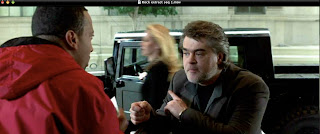|
| The action moves past us but does not pan; it then drops down to mid level where the action is taking place so it seems extremely close and dangerous. The use of close- up allows the audience to focus on an important detail in the screen (the chase) The blurriness of the behind action also makes us aware of whats happening without distracting us from the character. |
|
| The camera is right in the action, which makes the audience feel involved but safe knowing they will not be touched by what is happening on the screen. There is close up framing of the characters face and upper torso with tracking that quickly moves towards us creating an increasing sense of urgency. Also this effect shows us the seriousness of the chase by letting the audience see the different angles of the car whilst it quickly moves. |
|
| As we are behind the car we see the action as the character gets into the car, and also what the individuals are doing manically as the chase starts. We have a good view of what is about to happen as the far away building are still in view. The close up to the wheel as it sets off exaggerates the speed. The quick camera cuts from inside and outside the car also demonstrates the fast paced action of the character as well as the car. |
|
| As the car starts to speed up we see the interior of the car. The camera is in a close up position to show what is happening in detail, doing this to the gear stick it show him changing gears telling the audience that he is speeding up. The camera also changes to a low angle looking up to the driver, this brings significance to the driver, reminding us of the narrative. |
5.
| This scene is the start to the chase and the camera is facing the action as the car is wrecking through the market place, this makes us feel like it is coming towards us however we feel secure. The medium long shot of this dramatic clip gives the audience a sense of urgency on the characters part without exaggerating the action itself, which could seem rather cheap filming. The action spins away giving us a sense of drama and diversity. The camera is still as both cars are following each other at fast pace, this increases the sense of speed. |
|
| As the police are chasing the car, the camera is in the middle interior of the car facing towards the action, this makes us feel like we are part of the chase, specifically in the back seat; giving a sense of personification and edginess. The camera is also hand held meaning the audience feel like it is real and that they are part of it. Towards the end of this clip the camera does a close up shot of the police driver showing us the emotions of the character, resulting in the audience connecting with him. |
7.
| The camera is in a still position as the cars jump over the hilly roads. this demonstrates the diversity of the chase and exaggerates the movement. The camera also shows a quick long shot from the peak of the hill, viewing the whole location, making the chase a much wider film. The camera cuts as the as the cars are turning desperately around the corners, the quick turns when edited through cuts gives the audience a sense of havoc and aggression. |
|
| The camera has a close up of the male and his walky talky to show facial expression and the objects relevance to the scene without it being overshadowed. The camera is also hand held so it demonstrates the rough movements of the chase and creates a 3D sense. As the cars are going at fast speed in unstable conditions, the camera focuses on the slicing of the wheels from a diagonal view and a still image in front of the car as it crashes into another, this way the viewers can see the versatile movements of the car, not just on road. |

Tuesday, 23 October 2012
Rock extract
Labels:
analysis,
camera work,
edit,
rock
Subscribe to:
Post Comments (Atom)








No comments:
Post a Comment